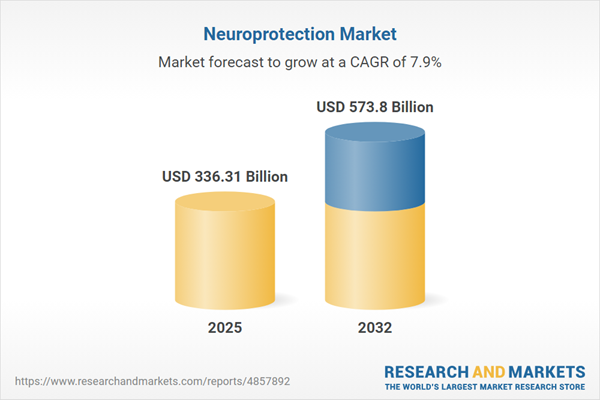Speak directly to the analyst to clarify any post sales queries you may have.
The neuroprotection market is experiencing fast-paced evolution, driven by advances in clinical research and new care models for neurological health. Senior decision-makers require reliable intelligence to proactively shape strategies that optimize outcomes in this dynamic sector.
Market Snapshot: Neuroprotection Market Growth and Trends
The neuroprotection market demonstrates robust global expansion, with industry experts projecting growth from USD 311.79 billion in 2024 to USD 336.31 billion in 2025. By 2032, market value is forecast to reach USD 573.80 billion, supported by a compound annual growth rate (CAGR) of 7.92%. Key contributors to this impressive momentum include heightened demand for precision therapies and advanced clinical interventions targeting neurological disorders. Biologic therapies, gene therapy platforms, and evolving regulatory frameworks play integral roles in driving sector advancement. Organizations investing in R&D, forging strategic partnerships, and upgrading distribution processes are well-positioned to secure competitive advantages within global neuroprotection markets.
Scope & Segmentation: Strategic Framework for Senior Decision-Makers
- Product Types: Biologics, monoclonal antibodies, neurotrophic factors, peptides, small molecule drugs, gene therapies, nutraceuticals, and stem cell therapies. These address a broad range of clinical requirements and empower the integration of personalized approaches into neurological treatment pipelines.
- Mechanisms of Action: Anti-inflammatories, antioxidants, calcium channel blockers, glutamate inhibitors, NMDA antagonists, and neurotrophic compounds. These mechanisms support diversified and targeted neuroprotection solutions tailored to complex diagnostic profiles.
- End User Segments: Hospitals, clinics, research institutes, and home healthcare providers. Each plays a distinct role in ensuring effective patient support, care delivery, and adherence to neurological treatment plans.
- Indications: Alzheimer’s disease, Parkinson’s disease, multiple sclerosis, stroke, neurotrauma, and additional neurological conditions. The need for adaptable, patient-centered interventions remains central to clinical innovation in the field.
- Distribution Channels: Hospital pharmacies, retail pharmacies, digital health platforms, and direct supply networks. These channels optimize market access, patient compliance, and responsiveness to regional healthcare infrastructures.
- Regions: Americas, EMEA, and Asia-Pacific. Each region presents unique regulatory requirements, commercial opportunities, and competitive environments, calling for region-specific operational and market entry strategies.
Key Takeaways: Insights for Neuroprotection Market Leadership
- Biologics and gene therapies are accelerating the development of highly specialized treatment pathways, enhancing the quality of outcomes for individuals with neurological disorders.
- Data-driven digital health technologies and integrated analytics tools allow for precise remote patient monitoring, supporting more agile and informed clinical decisions within neuroprotective settings.
- Strategic alliances and cross-border collaborations streamline product innovation and facilitate seamless navigation of evolving regulatory landscapes, reducing time to market and mitigating risk exposure.
- Emerging drug-delivery systems, such as those utilizing nanotechnology, drive improvements in treatment precision and patient adherence across acute and chronic care models for neuroprotection.
- Resilient supply networks and adaptable manufacturing operations strengthen ongoing organizational performance, providing safeguards against unpredictable regulatory changes or potential supply disruptions.
- Implementation of value-based care principles and dynamic reimbursement approaches aligns clinical practice with organizational priorities, enabling continuous operational advancement and higher-value patient outcomes.
Tariff Impact on Neuroprotective Therapeutics and Supply Chains in 2025
Forthcoming tariff changes in the United States prompt leadership teams to reassess production and sourcing strategies for neuroprotection therapies. Rapid shifts toward nearshoring and diversified active pharmaceutical ingredient sourcing are designed to enhance supply chain resilience, ensure cost efficiency, and maintain uninterrupted product availability. In a landscape marked by evolving policies, fostering strong supplier partnerships and maintaining proactive compliance will be essential to manage risk and protect organizational continuity.
Methodology & Data Sources
This report utilizes insights from industry executives, frontline clinicians, regulatory authorities, and independent analysts. Analysis is rooted in peer-reviewed research and cross-validated against established industry benchmarks, ensuring recommendations are based on the most reliable evidence available to support senior decision-making.
The Neuroprotection Market: Why This Report Matters
- Empowers executives to anticipate and adapt to regulatory evolution, changing research paradigms, and operational challenges within the neuroprotection landscape.
- Offers in-depth segmentation and region-specific analysis, enabling high-confidence decisions for strategic investments, partnerships, and enterprise risk management.
- Provides practical recommendations on digital health integration and supply chain optimization, equipping leaders to proactively address new policy and market requirements.
Conclusion
This report gives organizational leaders the actionable insights needed to anticipate change, prioritize innovation, and shape resilient strategies that advance performance in the global neuroprotection sector.
Additional Product Information:
- Purchase of this report includes 1 year online access with quarterly updates.
- This report can be updated on request. Please contact our Customer Experience team using the Ask a Question widget on our website.
Table of Contents
3. Executive Summary
4. Market Overview
7. Cumulative Impact of Artificial Intelligence 2025
Companies Mentioned
The companies profiled in this Neuroprotection market report include:- Eli Lilly and Company
- Roche Holding AG
- Novartis AG
- AstraZeneca PLC
- Biogen Inc.
- Pfizer Inc.
- AbbVie Inc.
- Johnson & Johnson
- Merck & Co., Inc.
- GlaxoSmithKline PLC
Table Information
| Report Attribute | Details |
|---|---|
| No. of Pages | 192 |
| Published | November 2025 |
| Forecast Period | 2025 - 2032 |
| Estimated Market Value ( USD | $ 336.31 Billion |
| Forecasted Market Value ( USD | $ 573.8 Billion |
| Compound Annual Growth Rate | 7.9% |
| Regions Covered | Global |
| No. of Companies Mentioned | 11 |









